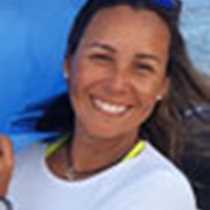Genovesa
Having crossed the Equator at about 3 a.m., we woke up with a new island within sight. Genovesa is also called “the bird island” because it is home to an estimated population of over one million birds. And we soon realized how overwhelming they are! We anchored within Darwin Bay; interestingly, this bay was formed when the roof of the magma chamber of Genovesa collapsed forming a large ‘cauldron’ which the sea invaded eventually. An early kayak outing allowed some of us to get a closer look at the many seabirds that live in the inside cliffs of the bay. During the morning we set foot on a little beach with white, coralline sands. There are many bushes and mangrove trees around, which are dotted with red-footed boobies. They have prehensile feet so they, unlike Nazca and blue-footed boobies, nest on trees or bushes. We found them in the middle of their breeding season: several of them were still incubating their single egg, and we even found chicks, fluffy and white, which stared at us with curiosity. Besides them we found many great frigatebird nests. Frigatebirds are known to be kleptoparasitic, therefore they steal the food other seabirds have fished for and they practice real acrobatics in the air. There have never been introduced land predators in this island, so we really had to be very careful as there were so many birds at ground level, either land or seabirds. We never stopped finding swallow-tailed birds, yellow-crowned night herons, Galápagos doves, and Darwin finches.
After the hike we returned to the beach, where some of our guests simply swam or relaxed, while others took the last chance for a deep-water snorkeling. Several Galápagos fur sea lions were there, some on the rocks, others in the water, and we were pleased with this since this is the first time we see them this week. This is a great place for spotting Moorish idols, blue-chin parrotfishes, and creole fishes, all very abundant in these waters.
This is our last afternoon in the Galápagos archipelago, and we have one more chance to enjoy the serenity of this uninhabited and isolated place. At Prince Philip’s Steps, on the eastern side of Darwin Bay, we had a last encounter with the many unique species that make this place so special: Nazca and red-footed boobies, great frigatebirds, swallow-tailed gulls, and Galápagos mockingbirds. The trail leads us through an incense tree forest, all of them leafless now that we are in the middle of the dry season. Once we reached the coastal part of the walk, we could observe a huge colony of Galápagos storm petrels. They nest in pockets in the lava, and their natural predator is usually not far. Short-eared owls here are the top predators, and since there is an abundance of petrels they have become their main prey. A blue, vast ocean surrounded us…Genovesa is far from the other Galápagos Islands. This isolation plus the innocence of the wildlife of this place made us remember how fortunate we are to be able to be here. Hasta pronto, Galápagos!




